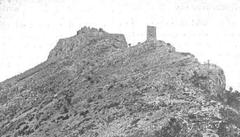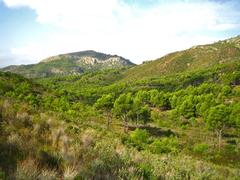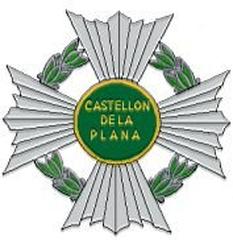Ermita De Santa Águeda Y Santa Lucía (Cabanes)
Visiting Hours, Tickets, and Historical Significance of Ermita de les Santes, Castelló de la Plana
Date: 25/07/2024
Introduction
Nestled within the serene and picturesque valley of the Serra de les Santes, the Ermita de les Santes is a hidden gem in Castelló de la Plana, Spain. This significant religious and cultural landmark is dedicated to Saints Águeda and Lucía and has been a site of pilgrimage and spiritual reflection since its establishment between 1340 and 1350. The hermitage is part of the Parc Natural del Desert de les Palmes, an area known for its natural beauty and historical significance. The origins of the Ermita de les Santes are steeped in tradition, where it is believed that the saints appeared to a hermit, instructing him to build the hermitage (Wikiloc). The architectural ensemble, comprising the main chapel, a hermit’s dwelling, and a guesthouse, reflects the rustic and functional design typical of the region’s hermitages (Turisme Cabanes). This guide provides comprehensive information about visiting Ermita de les Santes, including historical insights, architectural highlights, visitor tips, and details on nearby attractions, making it an essential read for anyone planning to explore this remarkable site.
Table of Contents
- Introduction
- The History and Architectural Significance of Ermita de les Santes
- Visitor Information
- The Fountain and Water Basin
- Nearby Historical Sites
- Special Events
- The Cross of Bartolo
- Restoration and Preservation
- Photographic Spots
- Conclusion
- FAQ
The History and Architectural Significance of Ermita de les Santes in Castelló de la Plana
Historical Background
The Ermita de les Santes, dedicated to Saints Águeda and Lucía, is located in the Serra de les Santes, within the Parc Natural del Desert de les Palmes in Castelló de la Plana, Spain. According to tradition, the saints appeared to a hermit at this location, instructing him to build an ermita (hermitage) between 1340 and 1350. This narrative underscores the site’s deep-rooted spiritual significance for the local community (Wikiloc).
Architectural Features
The architectural ensemble of the Ermita de les Santes is a testament to the rustic and functional design typical of hermitages in the region. The complex includes the main chapel, a hermit’s dwelling, and a spacious house-hospedería (guesthouse), all constructed using rough masonry left exposed, with traditional tile roofs. This construction style reflects the historical period and the practical needs of its inhabitants (Turisme Cabanes).
The Chapel
The chapel is a modest yet spiritually significant structure, featuring simple altars and religious iconography dedicated to Saints Águeda and Lucía. Its design emphasizes functionality and spiritual reflection, characteristic of hermitages intended for solitary religious devotion.
The Hermit’s Dwelling
Adjacent to the chapel is the hermit’s dwelling, a small, austere living space that provided the necessary accommodations for the hermits who resided there. This dwelling includes basic living quarters, a kitchen, and storage areas, reflecting the self-sufficient lifestyle of the hermits.
The Guesthouse
The guesthouse, or casa-hospedería, is a larger structure designed to accommodate pilgrims and visitors. This building includes multiple rooms for lodging, communal areas for dining and socializing, and facilities for cooking and storage. The guesthouse’s design facilitates the hospitality extended to visitors, reflecting the hermitage’s role as a place of pilgrimage and spiritual retreat.
Visitor Information
Visiting Hours and Tickets
The Ermita de les Santes is open to visitors year-round. Visiting hours typically range from 9:00 AM to 6:00 PM, but it is advisable to check the official website or contact local authorities for the most up-to-date information. Entry is usually free, but donations are welcomed to help with maintenance and preservation.
Guided Tours and Accessibility
Guided tours are available for those interested in a more in-depth exploration of the site. These tours provide valuable insights into the history and architecture of the hermitage. The site is generally accessible, but some areas may be challenging for visitors with mobility issues.
Travel Tips for Visitors
Visitors are encouraged to wear comfortable walking shoes and bring water, especially during the warmer months. The site offers several picturesque spots ideal for photography, so don’t forget your camera.
The Fountain and Water Basin
In front of the hermitage complex is a stone fountain and a water basin, integral to the site’s functionality and charm. The fountain, known for its appreciated waters, serves as a vital water source for the hermits and visitors. The water basin adds to the serene and picturesque environment of the hermitage (Wikiloc).
Nearby Historical Sites
While visiting the Ermita de les Santes, consider exploring nearby attractions within the Parc Natural del Desert de les Palmes. Other historical sites include the Monasterio de la Desierto de las Palmas and the Castillo de Montornés, offering a deeper dive into the region’s rich history.
Special Events
The annual pilgrimage to the hermitage, held on the last Sunday of October, is a significant event that draws visitors from across the region. This pilgrimage commemorates the historical and spiritual importance of the site, reinforcing its role as a place of worship and reflection (Wikiloc).
The Cross of Bartolo
Another notable feature near the Ermita de les Santes is the Cross of Bartolo (Creu del Bartolo), a monumental cross located at 690 meters above sea level near the summit of Pico del Bartolo. The current cross, which weighs around 90 tons and stands 24 meters tall, was blessed by Bishop José María Cases Deordal on May 12, 1985. The original cross was inaugurated in 1902, and the site has since become a significant landmark within the Parc Natural del Desert de les Palmes (Wikiloc).
Restoration and Preservation
Over the centuries, the Ermita de les Santes has undergone various restorations to preserve its structural integrity and historical significance. These efforts have ensured that the hermitage remains a vital part of the cultural and religious heritage of the region. Recent restoration efforts have focused on maintaining the original architectural features while incorporating modern preservation techniques to protect the site from environmental and structural degradation.
Photographic Spots
The Ermita de les Santes and its surroundings offer several scenic spots perfect for photography. The combination of historical architecture and natural beauty provides a stunning backdrop for capturing memorable moments.
Conclusion
The Ermita de les Santes is not only an architectural gem but also a beacon of historical and spiritual significance. Its rustic design, historical narrative, and cultural importance make it a must-visit destination for those interested in the rich heritage of Castelló de la Plana. The ongoing preservation efforts ensure that this historical site continues to inspire and attract visitors for generations to come.
FAQ
What are the visiting hours for Ermita de les Santes?
The Ermita de les Santes is generally open from 9:00 AM to 6:00 PM, but it’s best to check the official website for the most current information.
Are there guided tours available?
Yes, guided tours are available and provide valuable insights into the history and architecture of the hermitage.
How can I get to the Ermita de les Santes?
The hermitage is located within the Parc Natural del Desert de les Palmes. It’s advisable to use a reliable map or GPS for navigation.
Is there an entry fee for Ermita de les Santes?
Entry is usually free, but donations are welcomed to help with maintenance and preservation.




